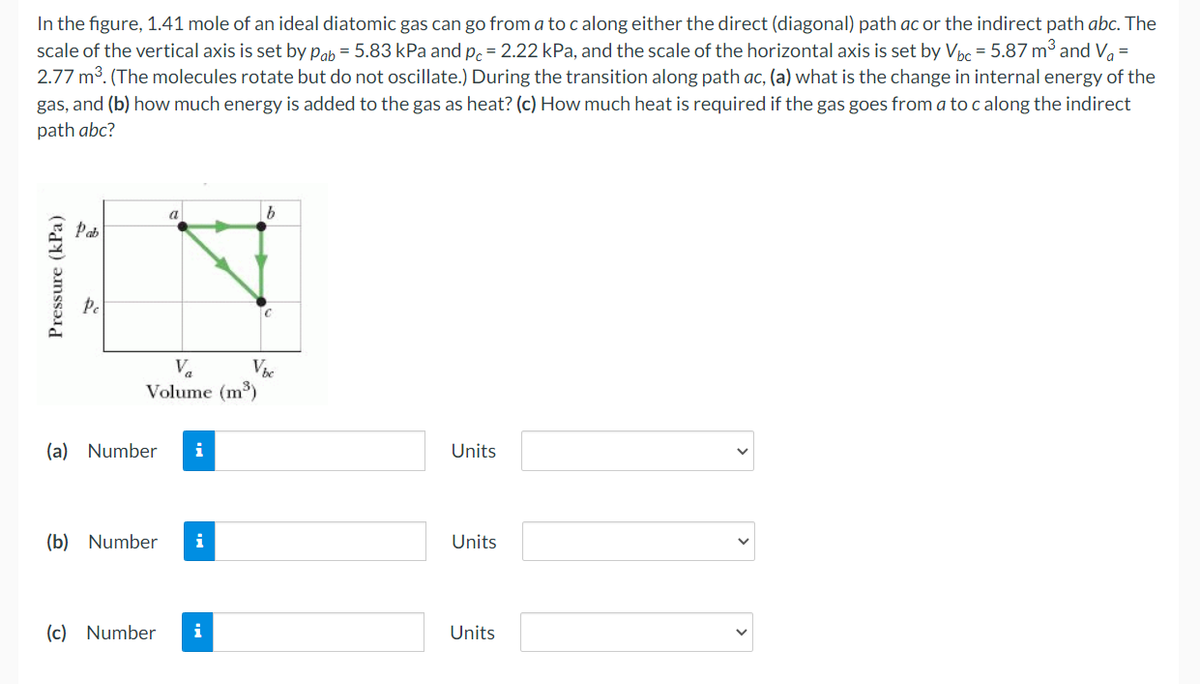In the figure, 1.41 mole of an ideal diatomic gas can go from a to c along either the direct (diagonal) path ac or the indirect path abc. The scale of the vertical axis is set by Pab= 5.83 kPa and pc = 2.22 kPa, and the scale of the horizontal axis is set by Vbc = 5.87 m³ and V₁ = 2.77 m³. (The molecules rotate but do not oscillate.) During the transition along path ac, (a) what is the change in internal energy of the gas, and (b) how much energy is added to the gas as heat? (c) How much heat is required if the gas goes from a to c along the indirect bath abc? Pressure (kPa) Pab Pe a V₂ Volume (m³) b C
In the figure, 1.41 mole of an ideal diatomic gas can go from a to c along either the direct (diagonal) path ac or the indirect path abc. The scale of the vertical axis is set by Pab= 5.83 kPa and pc = 2.22 kPa, and the scale of the horizontal axis is set by Vbc = 5.87 m³ and V₁ = 2.77 m³. (The molecules rotate but do not oscillate.) During the transition along path ac, (a) what is the change in internal energy of the gas, and (b) how much energy is added to the gas as heat? (c) How much heat is required if the gas goes from a to c along the indirect bath abc? Pressure (kPa) Pab Pe a V₂ Volume (m³) b C
Physics for Scientists and Engineers: Foundations and Connections
1st Edition
ISBN:9781133939146
Author:Katz, Debora M.
Publisher:Katz, Debora M.
Chapter21: Heat And The First Law Of Thermodynamics
Section: Chapter Questions
Problem 54PQ
Related questions
Question

Transcribed Image Text:In the figure, 1.41 mole of an ideal diatomic gas can go from a to c along either the direct (diagonal) path ac or the indirect path abc. The
scale of the vertical axis is set by Pab= 5.83 kPa and pc = 2.22 kPa, and the scale of the horizontal axis is set by Vbc = 5.87 m³ and V₁ =
2.77 m³. (The molecules rotate but do not oscillate.) During the transition along path ac, (a) what is the change in internal energy of the
gas, and (b) how much energy is added to the gas as heat? (c) How much heat is required if the gas goes from a to c along the indirect
path abc?
Pressure (kPa)
Pab
Pe
(a) Number
a
Va
Volume (m³)
(c) Number
i
(b) Number i
i
b
Vbc
Units
Units
Units
Expert Solution
This question has been solved!
Explore an expertly crafted, step-by-step solution for a thorough understanding of key concepts.
This is a popular solution!
Trending now
This is a popular solution!
Step by step
Solved in 2 steps

Knowledge Booster
Learn more about
Need a deep-dive on the concept behind this application? Look no further. Learn more about this topic, physics and related others by exploring similar questions and additional content below.Recommended textbooks for you

Physics for Scientists and Engineers: Foundations…
Physics
ISBN:
9781133939146
Author:
Katz, Debora M.
Publisher:
Cengage Learning


Principles of Physics: A Calculus-Based Text
Physics
ISBN:
9781133104261
Author:
Raymond A. Serway, John W. Jewett
Publisher:
Cengage Learning

Physics for Scientists and Engineers: Foundations…
Physics
ISBN:
9781133939146
Author:
Katz, Debora M.
Publisher:
Cengage Learning


Principles of Physics: A Calculus-Based Text
Physics
ISBN:
9781133104261
Author:
Raymond A. Serway, John W. Jewett
Publisher:
Cengage Learning

Physics for Scientists and Engineers, Technology …
Physics
ISBN:
9781305116399
Author:
Raymond A. Serway, John W. Jewett
Publisher:
Cengage Learning

Modern Physics
Physics
ISBN:
9781111794378
Author:
Raymond A. Serway, Clement J. Moses, Curt A. Moyer
Publisher:
Cengage Learning